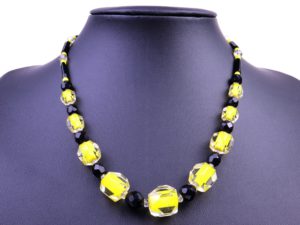Costume jewellery, or fashion jewellery, has been around since the 18th century and remains a staple to the fashion world. We wear it in adornment to complement our style.
What some people don’t know is that costume jewellery and fine jewellery fall under two separate categories. Costume jewellery is made out of inexpensive materials or imitation gems such as rhinestones making them more affordable than fine jewellery. However, some rare and high quality pieces of costume jewellery can be sold at a higher value.
Origins
The actual origin of costume jewellery cannot be specified but during the 18th century, jewellers began to manufacture cheaper alternatives to fine jewellery so that women could easily follow the latest trends without spending a fortune.
In 1724, French jeweller Georges Fréderic Strass introduced an inexpensive glass diamante jewellery which became popular with Parisian’s fashion. In 1892, Austrian jeweller Daniel Swarovski developed rhinestones that perfectly imitated gems such as emeralds and sapphires.
Through the decades, costume jewellery has significantly evolved to keep up with the changes in trends, especially with fine jewellery trends.
We explore the history of costume jewellery from its European origins to what we know of it today.
Art Deco Period
The art deco movement in the 1920’s and 1930’s greatly influenced the design for architecture, furniture, transport and jewellery. Jewellery designs consisted of Art Deco’s symmetric lines, geometric patterns and cubism designs. Some of the characteristics of the jewellery were chunky bangles, long earrings and narrow bracelets. Materials consisted of white metals, clear and coloured glass stones and beads, and faux pearls.

Retro period
Costume jewellery shifted from art deco to retro during 1930’s-1940’s due to the struggle of mass production during World War II and the Great Depression. The economy greatly influenced the production of costume jewellery by merging more natural materials with plastic ones. Jewellers sourced colourful and synthetic gemstones from America and designs included feminine and playful designs such as bows and flowers. Other characteristics included glamour, sophistication and Hollywood themes.
Art Modern Period
The art modern period followed after the war during 1945-1960. Retro jewellery pieces started to go out of style as trends led back to traditional jewellery designs. During this time period, jewellery was more tailored to the 50-60’s trends and was contemporary in design. Characteristics of jewellery became lighter and incorporated textures such as engravings and braid accents. Jewels were bold and luxurious using imitation gems such as rhinestones, topaz and citrine.
Styles of costume jewellery have evidently changed through the years with influences from art, culture and history. Today, they are fun collectible pieces that we use to complete the look of our outfit.
At Antiques of Kingston, we have all sorts of costume jewellery in stock from different eras. Shop our collection online or visit us in store.


